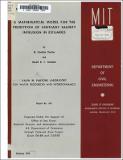A Mathematical Model for the Prediction of Unsteady Salinity Intrusion in Estuaries
Author(s)
Thatcher, M. Llewellyn; Harleman, Donald R. F.
Download911679043.pdf (8.933Mb)
Metadata
Show full item recordAbstract
The salinity structure of a tidal estuary fed by upstream fresh water sources is an important factor of water quality. In addition, this structure is intimately related to the circulation of the estuary because of density currents induced by the salt-fresh water relation. Previous investigations in two and three dimensions have been limited to extremely simplified geometrical and steady-state assumptions. One dimensional studies have considered the variable area case, but have been limited to descriptive rather than predictive methods because of the difficulty of handling the downstream boundary condition for the one-dimensional salt balance equation and because of the necessity to specify a longitudinal dispersion coefficient based on field data for the estuary being studied. This study presents a predictive numerical model of unsteady salinity intrusion in estuaries by formulating the problem in finite-difference terms using the one-dimensional, tidal time, variable area equations for the conservation of water mass, conservation of momentum and conservation of salt. Tidal time means a time scale of calculation larger than that defining turbulence, but much smaller than a tidal period in order to correctly represent the tidal advection within a tidal period. The tidal dynamic equations are coupled to the conservation of salt equation through a salinity-density relationship, and the ocean boundary condition for salt is formulated in a manner which depends on the direction of flow at the entrance to the estuary. The longitudinal dispersion coefficient has been shown to be proportional to the magnitude of the local, time-varying longitudinal salinity gradient, and this constant of proportionality has been shown to depend on a dimensionless parameter which expresses the degree of vertical stratification of the estuary. This relationship has been established for a wide range of stratification conditions. The mathematical model has been verified using data from the Waterways Experiment Station salinity flume and field data from the Delaware, the Potomac, and the Hudson. By specifying initial conditions, fresh water hydrographs, and tidal elevations at the ocean, it is possible to predict the time-varying salinity using this model.
Description
Prepared under the support of the Office of Sea Grant National Oceanic and Atmospheric Administration U. S. Department of Commerce through Coherent Area Project Grant GH-88 2-35150
Date issued
1972-02Publisher
Cambridge, Mass. : Ralph M. Parsons Laboratory for Water Resources and Hydrodynamics, Department of Civil Engineering, Massachusetts Institute of Technology
Other identifiers
144
Series/Report no.
R (Massachusetts Institute of Technology. Department of Civil Engineering) ; 72-10.Report (Ralph M. Parsons Laboratory for Water Resources and Hydrodynamics) ; 144.